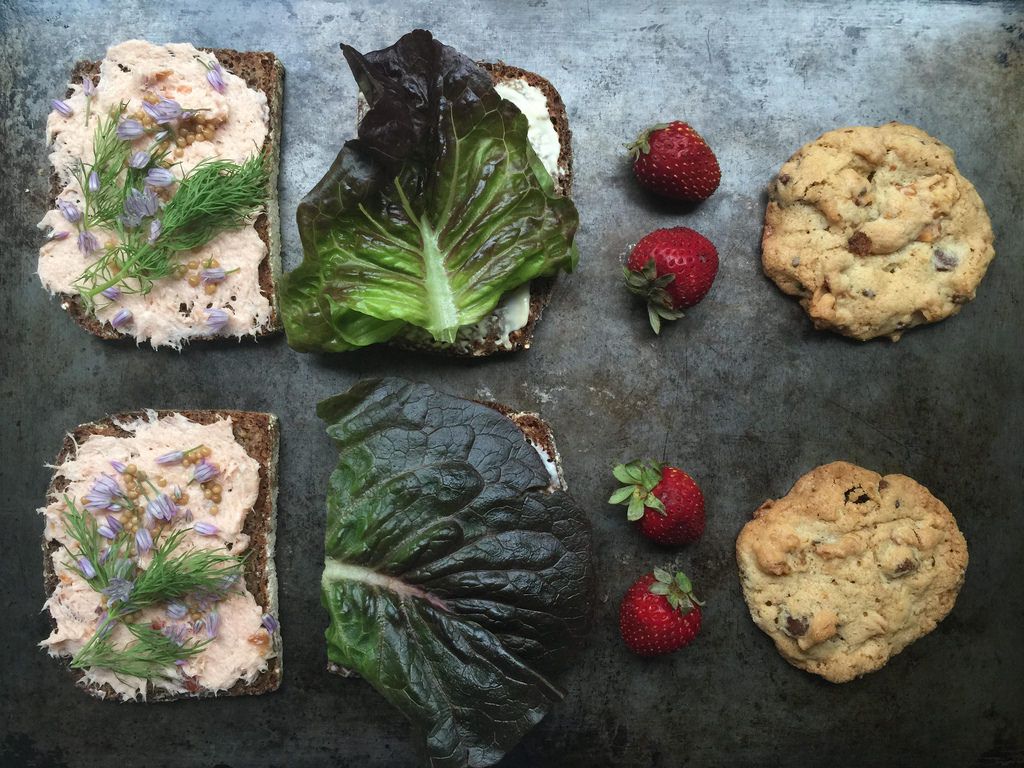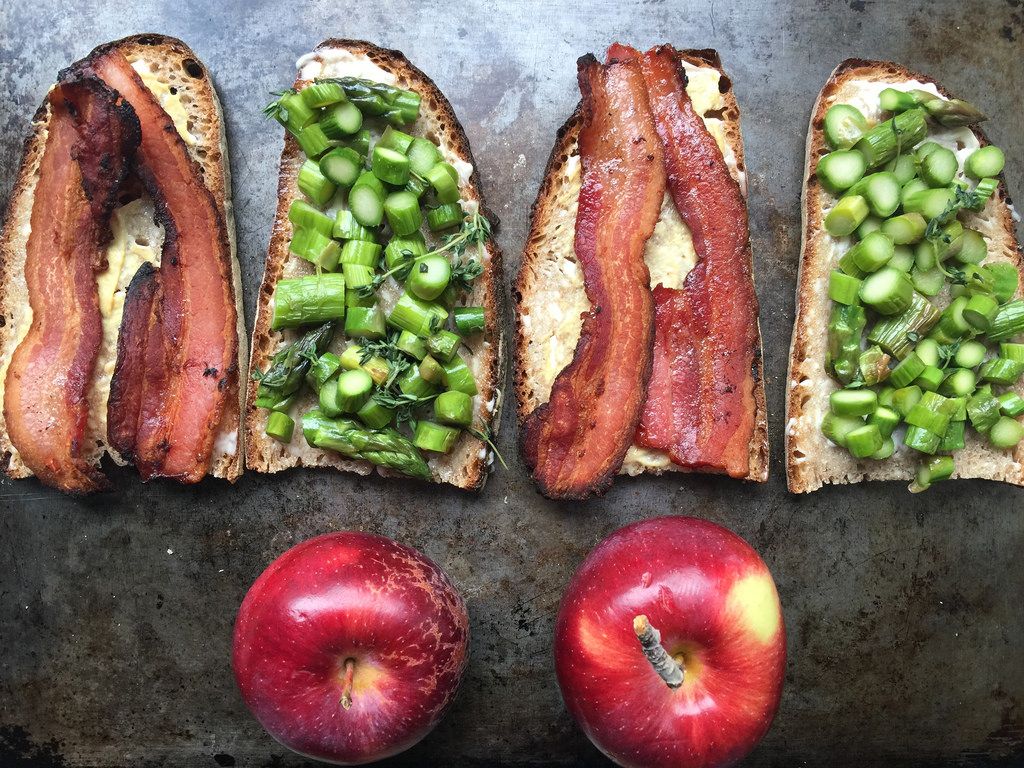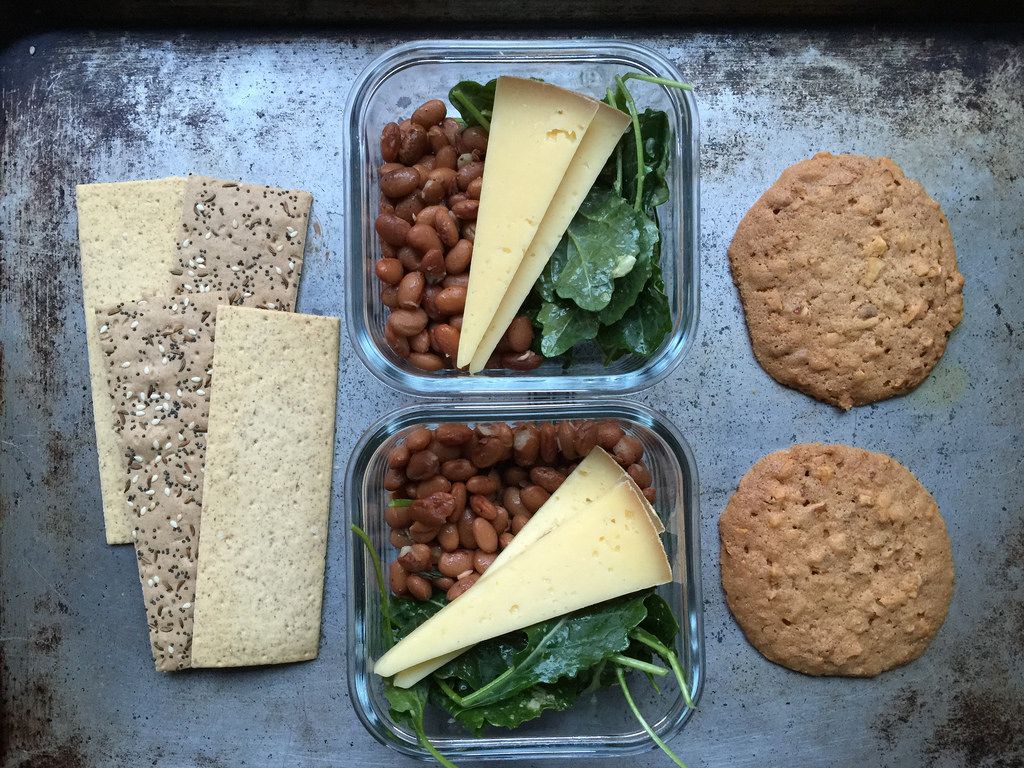Popular on Food52
28 Comments
monkeymom
July 13, 2015
I enjoy seeing these lunches and posts - they are lovely.
I'd just like to share that I am the parent of a picky eater even though my husband and I have always eaten a wide variety of foods. We alway offer and encourage our children to try different foods. However, for many of my youngest child's early years, it was often frustrating because they were consistently rejected. When my child turned 8, his world began to open up beyond 'white foods'. He saw his cousins eating sushi and began to explore more options. Now at 10 years old, he's eager to explore the adult menu and try all sorts of new fruits, vegetables and proteins of many colors. I'd just like to offer some hope to those parents who are trying and trying but might have a sensitive child. Eat the food you love and offer it with relish - It will show your child how wonderful food can be - and if he or she doesn't enjoy it then at least you will! p.s. I don't think my kids would eat any of the lunches that Amanda has ever posted. I'm fine with that. They eat lots of other healthy sandwiches and left-overs!
I'd just like to share that I am the parent of a picky eater even though my husband and I have always eaten a wide variety of foods. We alway offer and encourage our children to try different foods. However, for many of my youngest child's early years, it was often frustrating because they were consistently rejected. When my child turned 8, his world began to open up beyond 'white foods'. He saw his cousins eating sushi and began to explore more options. Now at 10 years old, he's eager to explore the adult menu and try all sorts of new fruits, vegetables and proteins of many colors. I'd just like to offer some hope to those parents who are trying and trying but might have a sensitive child. Eat the food you love and offer it with relish - It will show your child how wonderful food can be - and if he or she doesn't enjoy it then at least you will! p.s. I don't think my kids would eat any of the lunches that Amanda has ever posted. I'm fine with that. They eat lots of other healthy sandwiches and left-overs!
Aviva W.
June 29, 2015
Two thumbs up Amanda! We have done the same thing with our girls since they were babies. One family meal, pureed when they were babies, cut into little pieces when they were toddlers and now just on a plate now that they are 7 and 9. We try to make stuff they will like and do lots of DIY tacos, grain bowls, salads, etc so that they can control what goes on their plates. They absolutely go through phases of not liking various foods, but they are phases and will pass. As parents we just have to remind ourselves that they will eat whatever it is they are refusing to eat and not turn eating into a power struggle or source of conflict. This was the way I was raised and while I did think my mother was an ogre when she made beef stew (which I did apparently eat and enjoy - I still doubt this :) ), she did teach us about the pleasure of food and introduced us to the amazing foods from around the world. I documented my kids' lunches all year on instagram (@avivawittenberg if you want to take a look) to keep motivated to send healthy and delicious meals and more often than not, people asked me how it was I got my kids to eat "that" kind of food. Luckily they have friends who are adventurous eaters too and meals that creep outside the realm of traditional kids food aren't unusual for them. Definitely not always easy, but the rewards are huge!
ella11
June 12, 2015
I wanted to add - I like the idea of firm but gentle, and some of what you share is certainly in line with the very respectful, effective, and loving approach to feeding by Ellyn Satter - the Division of Responsibility. Parents decide the what and when and the children decide the if and how much. It's all about not pushing and trusting your child to know what they need, but more importantly, to not make mealtime a struggle.
Thanks for your great columns!
Thanks for your great columns!
Mayra G.
June 9, 2015
We have been giving kids pretty much everything we eat starting at 10 months, just chopped up smaller. This includes salads and spicy food. Now at age 7, on the more often than not hectic mornings, they end up eating leftovers like yams and rice or bean and avocado tostada for breakfast or lunch...whatever I can muster together. They did complain about their meals until I showed them an article in NY times magazine. http://www.nytimes.com/interactive/2014/10/08/magazine/eaters-all-over.html?_r=0
It has actually inspired us to broaden our meals .
It has actually inspired us to broaden our meals .
aacers
June 8, 2015
Bravo! I can only speak to my own experience as having been a kid (no kids of my own). When I was a kid, I always looked forward to dinnertime. My dad traveled a lot for business, and when he came home, he would show us menus from places he had been, and the food he had eaten; things we had never heard of! Also, my parents never made separate meals for us kids and them. If there was something new (my parents loved vegetables), they would first make a fuss about whatever it was (artichokes, for instance), and insist it was "too adult for our childish palates" and we could "have a taste" so that we wouldn't be wasting food if we turned up our noses at whatever it was. Of course, we always said we loved whatever we were eating, so that we would be seen as adults. Consequently, at age 57, I will try anything new, and there are very few foods I actively dislike. My mom and dad were so smart, and they did love sharing the food they loved with us.
witloof
June 7, 2015
When I was traveling in Europe in the early 90's, I was fortunate enough spend several extended visits with families who had small children. All of the children ate everything, including stinky cheeses, whole grain breads embedded with pumpkin and caraway seeds, liver patés, salads, and vegetables of every sort. When one of those children came to visit me in the states as a teenager, she was a fabulous restaurant companion, up for anything, and was lots of fun at the greenmarket and in the kitchen as well.
A European acquaintance who is living in the US said to me, "We should be feeding our children the best food. Why is it that people here choose to serve their children the worst food?" She's right! Why is it that people who know how important it is to put good fuel in their cars don't think to put good fuel into their little ones?
I work as a pediatric occupational therapist and it breaks my heart to see children living on cheddar goldfish, chicken nuggets, and Oreo cookies. So many behavioral and academic problems would be lessened if children ate better food. In order to manufacture the necessary neurotransmitters {serotonin and dopamine} that children need to focus for extended periods, filter out distractions, curb impulses, solve problems, and tolerate frustration, they have to consume plenty of foods that contain their essential building blocks. Those are, of course, fruits, vegetables, and whole grains. Growing brains need long chain fatty acids in order to develop neurological connections and lay down tracks. Children who eat a lot of food with denatured fats {denaturing fats prevents spoilage and break downs during deep frying} are at risk for neurological impairment and decreased IQ's.
Children are highly susceptible to inflammation. Eating foods that contain high amounts of pesticides, sugars, gluten, dairy, dried corn products and peanuts are at risk for gut and joint problems, among other long term health problems.
Two books that I like to recommend to parents are "Cure Your Child With Food" by Kelly Dorfman and "French Kids Eat Everything," by Karen Le Billon.
Even the pickiest eater will eat the healthiest food on his plate if he's hungry enough. If we stop doling out the goldfish, and make sure that children are hungry at mealtimes by making sure that they get enough exercise, they will eat what is set before them.
Thank you so very much for being a good example, Amanda. I think I'll add this column to my recommendations so that parents can see the possibilities {I live in NYC, so everyone has this kind of food available to them here}.
A European acquaintance who is living in the US said to me, "We should be feeding our children the best food. Why is it that people here choose to serve their children the worst food?" She's right! Why is it that people who know how important it is to put good fuel in their cars don't think to put good fuel into their little ones?
I work as a pediatric occupational therapist and it breaks my heart to see children living on cheddar goldfish, chicken nuggets, and Oreo cookies. So many behavioral and academic problems would be lessened if children ate better food. In order to manufacture the necessary neurotransmitters {serotonin and dopamine} that children need to focus for extended periods, filter out distractions, curb impulses, solve problems, and tolerate frustration, they have to consume plenty of foods that contain their essential building blocks. Those are, of course, fruits, vegetables, and whole grains. Growing brains need long chain fatty acids in order to develop neurological connections and lay down tracks. Children who eat a lot of food with denatured fats {denaturing fats prevents spoilage and break downs during deep frying} are at risk for neurological impairment and decreased IQ's.
Children are highly susceptible to inflammation. Eating foods that contain high amounts of pesticides, sugars, gluten, dairy, dried corn products and peanuts are at risk for gut and joint problems, among other long term health problems.
Two books that I like to recommend to parents are "Cure Your Child With Food" by Kelly Dorfman and "French Kids Eat Everything," by Karen Le Billon.
Even the pickiest eater will eat the healthiest food on his plate if he's hungry enough. If we stop doling out the goldfish, and make sure that children are hungry at mealtimes by making sure that they get enough exercise, they will eat what is set before them.
Thank you so very much for being a good example, Amanda. I think I'll add this column to my recommendations so that parents can see the possibilities {I live in NYC, so everyone has this kind of food available to them here}.
Amanda H.
June 7, 2015
Thanks very much -- French Kids Eat Everything has been on my list but I haven't read it yet. Also, I didn't address snacking -- it's another good topic to explore. We rarely give our kids snacks.
Tracy M.
June 8, 2015
Would you please post any peer-reviewed studies you have regarding foods & inflammation? I'm very interested.
aussiefoodie
June 8, 2015
Interesting column on kids snacks
http://www.washingtonpost.com/posteverything/wp/2015/05/28/no-you-cant-have-a-snack/
http://www.washingtonpost.com/posteverything/wp/2015/05/28/no-you-cant-have-a-snack/
witloof
June 8, 2015
Tracy, here is a brilliant book about curing inflammation with food. I've been following this diet myself for 8 months and after the second week, my health changed drastically for the better. I'm closing in on 60 and have no joint pain, no mood swings, no hot flashes, abundant energy, and weigh less than what I did when I graduated high school. {I've stopped telling people that it's hard to lose weight after 40, because it's simply not true. You just have to clean up your diet, stop eating inflammatory foods, and it will come off easily.} Highly recommend.
http://www.amazon.com/dp/0978858603/?tag=googhydr-20&hvadid=43720129195&hvpos=1t1&hvexid=&hvnetw=g&hvrand=12875933948873948881&hvpone=&hvptwo=&hvqmt=b&hvdev=c&ref=pd_sl_3mnvauma2z_b
http://www.amazon.com/dp/0978858603/?tag=googhydr-20&hvadid=43720129195&hvpos=1t1&hvexid=&hvnetw=g&hvrand=12875933948873948881&hvpone=&hvptwo=&hvqmt=b&hvdev=c&ref=pd_sl_3mnvauma2z_b
gmg2011
June 5, 2015
Brava! We have always done this. Dinner is family time, with very few exceptions and even our 2 year old is at the table with us. Everyone must try at least 1 bite of everything. There is typically at least one thing on the plate that each of our 3 children will eat (not necessarily one thing all of them will eat). Once a week they eat with the sitter and that one meal tends to be pasta or chicken they all like, certainly less challenging to them.
Our first child was an adventurous eater until about 2, then we entered what I call the "dark period." Our second was never very adventurous, and is now 4--she at least know she has to try things even if she does't like them. Our third is just 2 and loves pretty much everything we place in front of him.
Here is the best part though! After 5 1/2 years of being made to try foods, our oldest (now nearly 8) is coming out the other side of this "dark period." He tries new foods willingly and often likes them. It only took 5 1/2 years of cajoling and insisting. It is great to see that is going to pay off in the end. Just 3 more years until his sister comes out of her life-long "dark period."
Our first child was an adventurous eater until about 2, then we entered what I call the "dark period." Our second was never very adventurous, and is now 4--she at least know she has to try things even if she does't like them. Our third is just 2 and loves pretty much everything we place in front of him.
Here is the best part though! After 5 1/2 years of being made to try foods, our oldest (now nearly 8) is coming out the other side of this "dark period." He tries new foods willingly and often likes them. It only took 5 1/2 years of cajoling and insisting. It is great to see that is going to pay off in the end. Just 3 more years until his sister comes out of her life-long "dark period."
Micheal H.
June 5, 2015
Sure, this will work for many (most?) kids, but there are other kids out there (like my own) who have sensory issues that make eating a very difficult experience. I have friends who just got their 4yo to eat chicken nuggets after 2 years of occupational therapy. The advice that we "just need to insist" doesn't work for every kid.
Margaret
June 5, 2015
I do agree with this (though I understand that different kids and different families will approach this in a myriad of ways. We make our kids try at least a bite of everything. It may turn out to be a hit (most of the time they were just a little sketched out by the way the food looks) and it may not, and that's ok. I don't force myself to choke down foods I hate for kicks. And sometimes, when my six year old complains about broccoli (a food he generally likes), I remind him that not everything in life will be fun and exciting and sometimes you just have to eat the things that are good for you (I do make myself eat salads when I would rather have a gooey grilled cheese). I think you're doing a great job of introducing your kids to new experiences!
Rachel H.
June 5, 2015
How soon did you start this? We have a 10 mth old that we've been giving baby food, but want to transition her to real people food and are so unsure about where and how to start? Any advice?
Margaret
June 5, 2015
I have an eleven month old (she's our third, so I've done this before) and I've been doing a mix of purees, cheerios and real people food. Check out the book Baby-led Weaning, I didn't use it exclusively but it did give me confidence that babies can eat a lot more than the baby food aisle would have you think. If you start with simple-ish meals, just give her bites from your dinner table. Last night my daughter had a couple pieces of roasted potatoes, steamed broccoli florets and some pan-fried chicken. I stay away from a lot of grease, sugar, tomato dishes (acidity) and overly salted things, but we're getting more and more adventurous as she shows her body is handling it well. If you want to just get started, give her frozen steamed veggies like green beans, peas, carrots, butternut squash. They tend to be softer so she can get used to chewing. And don't be afraid of using herbs and spices in your cooking.
Amanda H.
June 7, 2015
Hi Rachel -- Margaret's advice is great. When our kids were starting to eat solid foods, I was working on a cookbook, so I just fed them what we were eating, mostly pureed, and sometimes chopped up. I also did plain purees and baby food, which I now sort of regret -- then, I didn't know that babies could chew as much as they can at that age and I was a bit timid. Merrill has written a whole column about feeding her daughter Clara real food from a very young age -- here's one of the first (if not the first) posts: https://food52.com/blog/4449-carrots-cooked-forever -- you might find it helpful.
EmilyC
June 5, 2015
Thanks for sharing, Amanda. This post fits right in with Nick's column title yesterday, and I really respect his and your approaches. (And I can totally relate to being more firm and consistent at the dinner table than with bedtime -- that line made me laugh!) Even though the lunches I pack for my son aren't nearly as interesting or varied as what you post here, I love the nudge to try harder. So thank you.
istvan
June 5, 2015
When we had our first child, we did this, and thought, how clever we are, the kid eats everything, yes consistency works, hurrah, every other parent who cannot do this is just lazy... Then we had a second one, and although we did everything the same, did not offer choices, she just did not turn out the same, she is an extremely picky eater, and while you can minimize the effect, it just does not go away. So count yourself lucky, that the strategy worked, but don't assume, that it will work for every kid, and that the parents are lazy if it is not...
Amanda H.
June 5, 2015
HI Istvan -- thanks for your note. There are always exceptions, and I never suggested parents who don't do this are lazy. That is your word selection.
monkeymom
July 13, 2015
Hi Amanda,
Though the word "lazy" was not used, the phrase "the Age of Coddling" was. This implies that those that don't do the strategy coddle their children. I'm not opposed to the strategy at all but I don't think it is out of line to feel like there is a subtle judgement being conveyed here.
Though the word "lazy" was not used, the phrase "the Age of Coddling" was. This implies that those that don't do the strategy coddle their children. I'm not opposed to the strategy at all but I don't think it is out of line to feel like there is a subtle judgement being conveyed here.





See what other Food52 readers are saying.